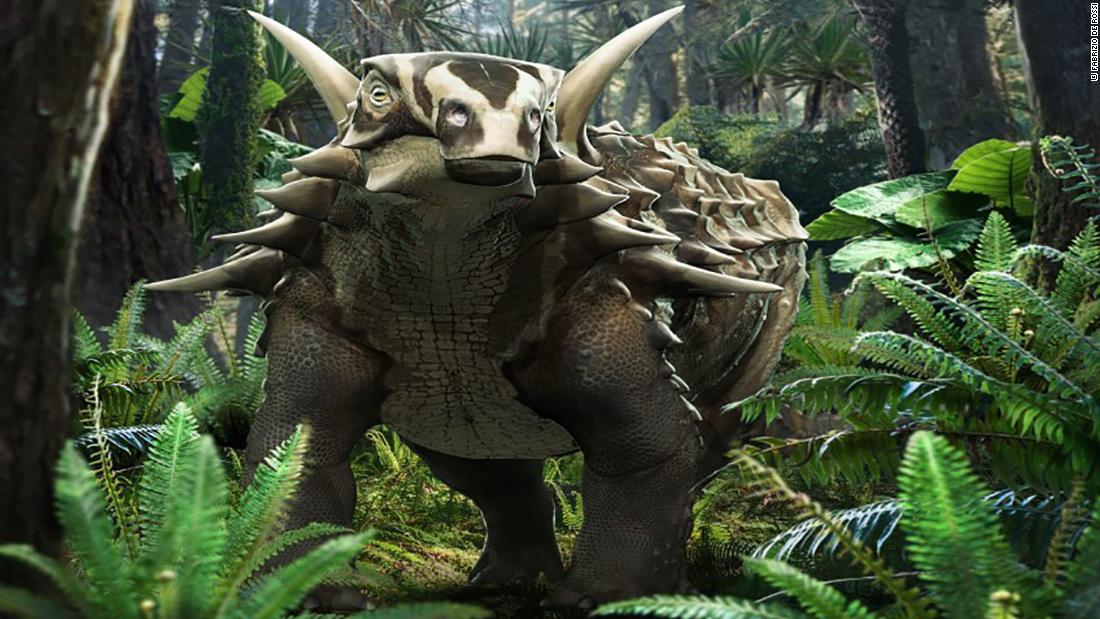Dinosaur footprints discovered in Wales 0:59
(CNN) --
Life as a "living fortress" was lonely for this dinosaur.
According to a new study, this heavily armored nodosaur, with elongated spikes on its neck and shoulders, was probably a slothful loner that couldn't hear very well.
The researchers studied the brain of this 80-million-year-old herbivorous dinosaur, related to the famous club-tailed ankylosaurs.
A new armored dinosaur found in Chile had a strange weapon-like tail
The Struthiosaurus austriacus fossil was first discovered in Austria and has been in the collection of the Vienna Institute of Palaeontology since the 19th century.
While some of these heavy, tank-like ankylosaurs could reach 8 meters in length, Struthiosaurus was relatively small at 2.7 meters.
To better understand the hearing and balance of Struthiosaurus, this armored dinosaur, researchers analyzed its tiny 50-millimeter brain using a micro-CT, or micro-computed tomography, scanner to create a 3D digital cast.
Although dinosaur brain tissue is too fragile to preserve, the neurocranium -- the tissue that covers the structure of the brain -- can reveal aspects of a dinosaur's lifestyle.
The results were published last week in the academic journal Scientific Reports.
advertising
This illustration shows Struthiosaurus austriacus, a "living fortress" dinosaur that lived 80 million years ago in Austria.
What the neurocranium reveals
This dinosaur had a very small floc, a key part of the brain for eye fixation when the head, neck, or body is in motion, especially when watching competitors or predators.
The finding, combined with the semicircular shape of its internal ear canals, suggests that this dinosaur moved very slowly.
According to the researchers, rounded ear canals allow greater sensitivity than semicircular ones, which could interrupt the flow of vibrations and nerve impulses.
In life, this animal would have been very passive and lazy, rather than acting like an aggressor, and could "take care of itself to survive," said study author Marco Schade, a paleontologist at the University of Greifswald in Germany.
The dinosaur was not blind and would have been able to see predators coming.
"While some of its relatives probably defended themselves with their club-like tails, Struthiosaurus probably relied more on its distinctive armor (for protection)," employing a passive style of self-defense, Schade said in a statement.
"Other than that, it's very likely that carnivorous dinosaurs tended to hunt quietly, contrary to the monstrous way they're portrayed in 'Jurassic Park,'" he said.
This impressive paleo art shows what real dinosaurs looked like
The braincase also revealed the shortest cochlea ever found in a dinosaur.
The cochlea is part of the inner ear, where hearing occurs, and its size can determine hearing ability.
"These observations are consistent with an animal that has adapted to a comparatively inactive lifestyle with limited social interactions," the study authors wrote.
It wasn't the most popular
Scientists believe that many dinosaurs lived and traveled in groups, but this species of ankylosaur probably lived alone due to its poor hearing ability.
The Struthiosaurus dinosaur could be found chewing on low-growing plants in coastal areas and had great bite force to chew through tough vegetation.
Great Argentine discovery: dinosaur eggs discovered 0:54
"The animal's hearing was obviously not well developed, so if necessary, Struthiosaurus communicated with others in a way other than vocalizations," said study co-author Cathrin Pfaff, a research associate and head of the Struthiosaurus facility. micro-CT at the Institute of Paleontology at the University of Vienna, in a statement.
However, Struthiosaurus "wasn't completely incapable of hearing others," Schade said, and like modern turtles, it probably only used sound to communicate when absolutely necessary.
"Paleontologists don't really consider ankylosaurs in general to be particularly social animals, but since sound-based intraspecific communication is a popular means of communication among animals, the somewhat limited hearing capabilities of nodosaurs may suggest that they didn't much appreciate having company, nor the full range of frequencies of complex classical music," Schade wrote by email.
Next, the researchers want to take a closer look at the brains of other European ankylosaurs to see if these findings are unique to one species or represent something other dinosaurs in their family evolved.
dinosaurs

